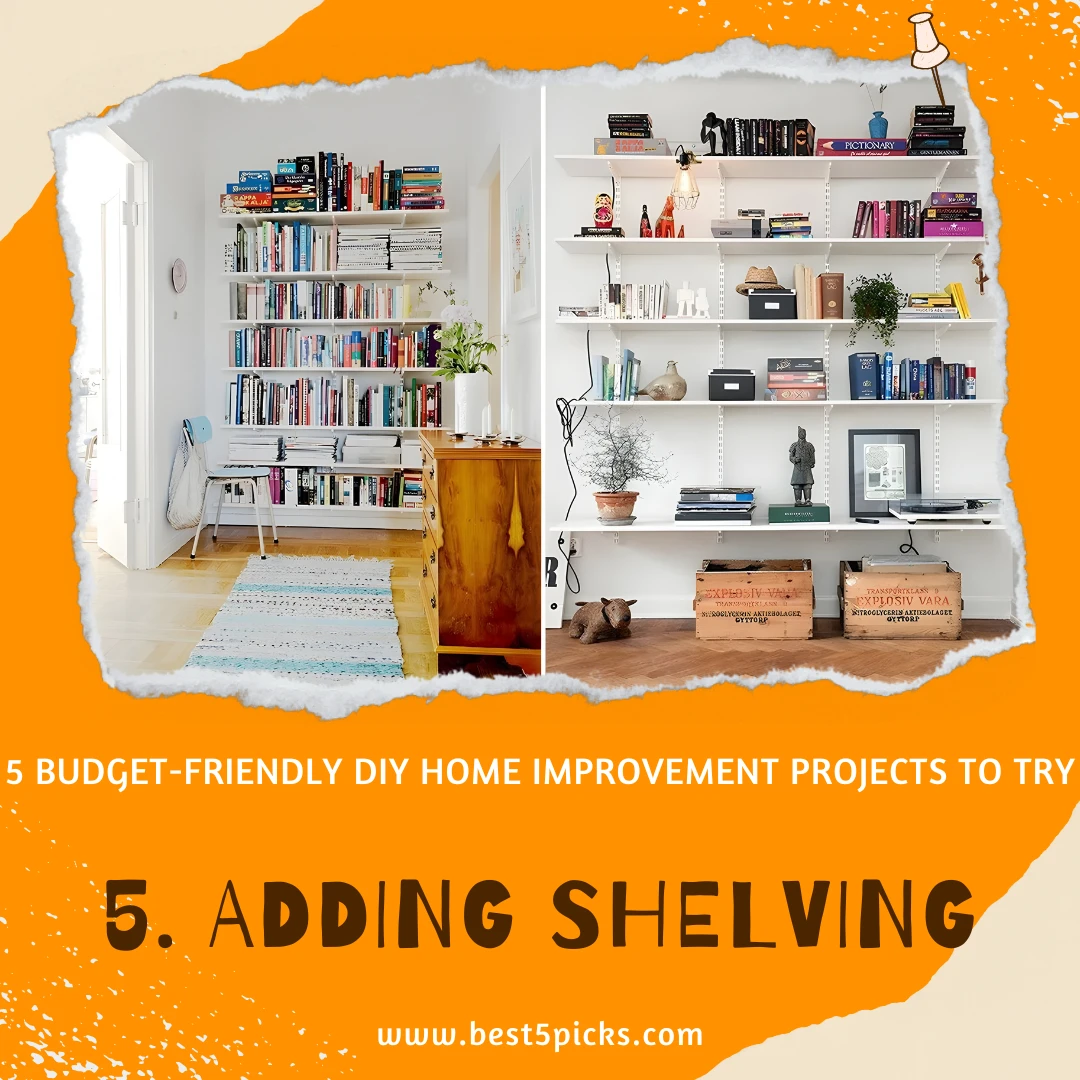Looking to spruce up your home without breaking the bank??? Check out these 5 cheap DIY home improvement ideas that will breathe new life into your space without draining your wallet.
From simple decor hacks to budget-friendly renovations, these projects are perfect for adding a fresh touch to any room in your house.
In this article, we’ll explore creative ways to enhance your home’s aesthetic appeal without spending a fortune.
Are You In Hurry? Then Check Out Below!
Whether you’re looking to update your kitchen, revamp your living room, or add some personality to your bedroom, these affordable DIY ideas will inspire you to get started on transforming your home into the stylish sanctuary you’ve always dreamed of.
I. Introduction
Transform your home without breaking the bank! Discover 5 budget-friendly DIY home improvement hacks. Revamp your space today!
A. Importance of home improvement projects
Home improvement projects are essential for maintaining and enhancing the value, functionality, and aesthetic appeal of your home.
They allow you to customize your living space according to your preferences and needs.
Regular home improvements also help prevent major issues and costly repairs in the future.
By investing time and effort into improving your home, you can create a more comfortable and enjoyable living environment for yourself and your family.
B. Benefits of DIY projects
DIY (Do-It-Yourself) projects offer several advantages for homeowners.
Firstly, they can save you a significant amount of money compared to hiring professionals for every task. DIY projects allow you to bypass labor costs and instead invest in materials and tools.
Additionally, DIY projects provide a sense of accomplishment and satisfaction as you take ownership of the improvements made to your home. They also give you the freedom to unleash your creativity and personalize your living space to reflect your unique style.
II. 5 Cheap DIY Home Improvement Ideas: Transform Your Space on a Budget
Looking to improve your home on a budget? Check out this article outlining 5 budget-friendly DIY home improvement projects you can try.
Discover the benefits of tackling these projects yourself and learn tips for achieving professional results.
From painting and installing a backsplash to updating cabinet hardware and creating a gallery wall, we’ve got you covered.
Find affordable options and step-by-step guides to transform your home without breaking the bank.
Start enhancing your space today with these cost-effective ideas!
1. Painting

A. Choosing the right paint colors
1. Consider the room’s purpose and desired atmosphere
2. Take into account existing furniture and decor
3. Use color samples and swatches to test different options
4. Consider natural lighting and how it affects paint colors
5. Research color psychology to understand the impact of different hues
B. Preparing the walls
- Clean the walls thoroughly to remove dirt, dust, and grease
- Repair any cracks, holes, or imperfections with spackling or putty
- Sand the walls to create a smooth surface
- Apply primer to help the paint adhere better and achieve a more even finish
- Protect floors, furniture, and fixtures with drop cloths or plastic sheets
C. Tips for achieving a professional finish
1. Use high-quality paint brushes and rollers for better coverage
2. Start with a cutting-in technique, painting the edges and corners with a brush
3. Use long, even strokes when applying paint to avoid visible brush marks
4. Apply multiple thin coats of paint rather than one thick coat
5. Allow each coat to dry completely before applying the next
6. Remove painter’s tape carefully to avoid peeling off fresh paint
D. Cost-effective painting supplies
- Look for affordable paint brands or consider purchasing mistinted paint at a discounted price
- Opt for synthetic brushes or foam rollers, which are often more budget-friendly than natural bristle brushes
- Purchase paint in larger quantities, as it is often more cost-effective per gallon
- Consider borrowing or renting painting equipment, such as ladders or paint sprayers, instead of buying them
- Use reusable paint trays and liners instead of disposable ones to save money in the long run
In this artical “5 Cheap DIY Home Improvement Ideas” journey next project is Installing a backsplash.
2. Installing a Backsplash

A. Selecting a Suitable Backsplash Material
1. Consider your budget: Look for affordable options that fit within your budget. Some materials, such as ceramic tiles and peel-and-stick backsplash sheets, are generally more cost-effective.
2. Assess durability: Ensure that the material you choose is resistant to moisture, heat, and stains, especially if it will be installed in a kitchen or bathroom.
3. Evaluate maintenance requirements: Opt for a backsplash material that is easy to clean and maintain, as this will save you time and effort in the long run. Materials like glass, metal, or vinyl are typically low-maintenance.
4. Explore design options: Select a backsplash material that complements the overall aesthetic of your space. Consider factors such as color, texture, and pattern to find a material that enhances your existing decor.
B. Measuring and Preparing the Area
- Measure the space accurately: Use a measuring tape to determine the dimensions of the area where the backsplash will be installed. Take into account any outlets, switches, or other obstacles.
- Prepare the surface: Ensure that the wall is clean, dry, and smooth. Remove any existing tiles, wallpaper, or debris. Fill in any holes or cracks with spackle and sand them down for a smooth surface.
C. Step-by-Step Installation Process
1. Lay out the design: Plan the layout of your backsplash by dry-fitting the tiles or sheets on the wall. This will help you visualize the final result and make any necessary adjustments.
2. Apply adhesive: Depending on the type of backsplash material, apply the appropriate adhesive to the wall using a notched trowel. Follow the manufacturer’s instructions for the recommended adhesive and spreading technique.
3. Install the backsplash: Place the tiles or sheets onto the adhesive, starting from the bottom and working your way up. Use spacers to ensure even spacing between the tiles. Press firmly to ensure proper adhesion.
4. Cut tiles if necessary: If you encounter areas that require smaller or partial tiles, use a tile cutter or a scoring tool to cut them to the desired size. Be cautious and wear protective goggles when cutting tiles.
5. Grout the tiles: Once the adhesive has dried, remove the spacers and apply grout between the tiles using a grout float. Wipe away any excess grout with a damp sponge. Allow the grout to cure according to the manufacturer’s instructions.
6. Seal the grout (if needed): Some types of grout may require sealing to prevent staining. Refer to the specific grout manufacturer’s instructions for guidance on sealing and the recommended frequency of reapplication.
D. Affordable Backsplash Options
- Ceramic or porcelain tiles: These are commonly available and cost-effective options. They come in various colors, patterns, and sizes, allowing you to find a style that fits your aesthetic.
- Peel-and-stick backsplash sheets: These self-adhesive sheets are easy to install and can mimic the look of more expensive materials like glass or metal.
- Vinyl wallpaper or decals: Vinyl options provide a wide range of designs and are generally more affordable than other materials. They are also easy to clean and maintain.
- Painted backsplash: If you’re on a tight budget, consider painting a backsplash. Use a washable and durable paint suitable for the kitchen or bathroom and apply a protective topcoat to make it easier to clean.
- Subway tiles: Subway tiles are a timeless and cost-effective choice for a backsplash. They come in a variety of materials such as ceramic, porcelain, or even peel-and-stick options, making them versatile and budget-friendly.
- Stainless steel or aluminum sheets: These metal backsplashes can give your kitchen a sleek and modern look. They are relatively affordable and easy to install, providing a durable and low-maintenance option.
- Beadboard paneling: Beadboard is a type of paneling that adds a charming and rustic touch to any space. It is often made of wood or vinyl and can be installed as a backsplash for an affordable and visually appealing option.
- Chalkboard paint: If you want a unique and functional backsplash, consider using chalkboard paint. It allows you to write notes, recipes, or create artistic designs while adding a touch of creativity to your kitchen or workspace.
E. Additional Tips for Budget-Friendly Backsplash Installation
1. Shop for sales and discounts: Keep an eye out for sales, clearance items, or discounted tiles at home improvement stores. You might find quality materials at a fraction of the original price.
2. Consider DIY tile cutting: If you choose a tile backsplash, cutting the tiles yourself can save money compared to purchasing pre-cut tiles. Renting a tile cutter or using tile nippers can be more cost-effective options.
3. Explore alternative tile shapes and sizes: Non-traditional tile shapes, such as hexagons or arabesque patterns, can add visual interest to your backsplash while being more affordable than intricate mosaic designs.
4. Mix high-end and budget materials: To achieve a stylish and unique look while staying within budget, consider combining a few pricier tiles or materials as accent pieces and fill the rest with more affordable options.
5. DIY installation: Installing the backsplash yourself instead of hiring a professional can significantly reduce costs. With careful planning and following step-by-step instructions, you can achieve professional-looking results while saving money.
By exploring affordable backsplash options and utilizing cost-saving techniques, you can transform the look of your kitchen or bathroom without breaking the bank.
Remember to choose a material that fits your style, consider the durability and maintenance requirements, and enjoy the process of creating a budget-friendly backsplash that adds charm and value to your home.
In this artical “5 Cheap DIY Home Improvement Ideas” journey next project isUpdating cabinet hardware.
3. Updating Cabinet Hardware

A. Importance of Cabinet Hardware
1. Enhances the aesthetics: Cabinet hardware serves as decorative elements that can instantly update the look of your cabinets and give them a fresh, modern, or classic appeal.
2. Improves functionality: Upgrading cabinet hardware can make it easier to open and close drawers and doors, providing a smoother user experience.
3. Adds personal touch: By choosing hardware that reflects your personal style, you can add a unique and customized touch to your cabinets, making them stand out.
B. Different Types of Hardware
- Knobs: Knobs are small, rounded handles that are attached to cabinets with a single screw. They are commonly used on cabinet doors and come in various materials, such as metal, wood, or glass, offering a wide range of design options.
- Pulls: Pulls are longer handles that are attached to cabinets with multiple screws. They are often used on drawers but can also be used on cabinet doors. Like knobs, pulls come in various styles, sizes, and finishes to suit different design preferences.
- Handles: Handles are similar to pulls but have a more streamlined design. They are usually mounted horizontally on cabinet doors and drawers, providing a sleek and modern look.
- Backplates: Backplates are decorative plates that are mounted behind knobs or pulls. They not only add an extra layer of style but also protect the cabinet surface from scratches caused by hardware.
C. Removing Old Hardware and Preparing for Installation
1. Remove existing hardware: Use a screwdriver to remove the screws that attach the old hardware to the cabinets. Keep the screws aside for later use or replace them if necessary.
2. Clean the cabinet surfaces: Wipe down the cabinet doors and drawers to remove any dirt, grease, or residue. This ensures a clean and smooth surface for the new hardware.
3. Fill holes and touch up paint (if needed): If the new hardware has a different hole configuration than the old one, fill the old holes with wood filler. Allow it to dry, sand it smooth, and touch up the paint or stain if necessary.
D. Affordable and Stylish Hardware Options
- Hardware stores and online retailers: Visit local hardware stores or explore online retailers that offer a wide range of cabinet hardware options at various price points. Look for sales or discounted items to find affordable deals.
- Thrift stores and flea markets: Consider visiting thrift stores or flea markets where you can find unique and vintage hardware pieces at budget-friendly prices. With a little cleaning and polishing, these pieces can add character to your cabinets.
- DIY options: Get creative and transform existing hardware with a fresh coat of paint or spray paint. This allows you to customize the color and finish of the hardware to match your desired aesthetic while saving money.
- Mix and match: Create an eclectic and personalized look by mixing different types of hardware. Combine knobs with pulls or handles for a unique and stylish cabinet design.
- Consider alternatives: Inexpensive alternatives to traditional hardware include rope pulls, leather straps, or even repurposed objects like vintage doorknobs or drawer pulls. These options can add a touch of creativity and uniqueness to your cabinets.
By updating the cabinet hardware, you can transform the look and feel of your cabinets without breaking the bank.
Take your time to explore various options and choose hardware that complements your overall design scheme while providing the functionality you desire. In this artical “5 Cheap DIY Home Improvement Ideas” journey next project isCreating a gallery wall.
4. Creating a Gallery Wall

A. Selecting artwork and frames
1. Consider the theme or style: Choose artwork that complements the overall aesthetic of your space. Whether you prefer abstract paintings, vintage photographs, or motivational quotes, select pieces that resonate with you.
2. Size and proportion: Vary the sizes of the artwork to create visual interest. Mix larger pieces with smaller ones for balance.
3. Color coordination: Ensure that the colors in your artwork harmonize with the room’s color scheme. You can opt for a cohesive palette or create a striking contrast for a bold statement.
4. Framing options: Select frames that enhance the artwork and blend well with your interior. Consider using a mix of frame colors and materials to add texture and depth.
B. Planning the layout
- Measuring and marking: Measure the available wall space and mark the dimensions on the floor. This will help you visualize the layout before hanging the frames.
- Creating a mock-up: Lay out your artwork on the floor or a large table to experiment with different arrangements. Play around with the positioning and spacing until you achieve a balanced composition.
- Consistency and symmetry: Decide whether you want a symmetrical arrangement with evenly spaced frames or a more eclectic display with varying heights and angles. Both approaches can create stunning gallery walls, so choose the style that suits your taste and space.
C. Hanging the frames
- Gather your tools: You’ll need a tape measure, a level, a hammer, nails, and picture hanging hooks or adhesive strips.
- Preparing the wall: Clean the wall surface and fill any holes or imperfections with spackle. Allow it to dry and sand it smooth if necessary.
- Hanging techniques:
- Hammer and nails: Measure the desired placement for each frame, mark it with a pencil, and then hammer the nails into the marked spots. Hang the frames on the nails, ensuring they are straight using a level.
- Picture hanging hooks or adhesive strips: These options are great for avoiding nail holes. Follow the manufacturer’s instructions for proper application and weight limits.
D. DIY artwork ideas
- Personal photographs: Print and frame your favorite family photos or travel snapshots for a personalized touch.
- Inspirational quotes: Create your own inspirational quote art by printing quotes on decorative paper or painting them on canvas.
- Collages and fabric art: Arrange cut-out magazine images or fabric swatches in a creative collage or use fabric pieces stretched over canvases for a textured and unique look.
- Nature-inspired art: Press and frame leaves, flowers, or ferns for a natural and botanical aesthetic.
- Abstract or geometric art: Paint your own abstract or geometric designs on canvas or create minimalist artwork using simple shapes and colors.
Remember, the key to a successful gallery wall is to experiment, be creative, and have fun. Don’t be afraid to rearrange the frames until you achieve the desired look. In this artical “5 Cheap DIY Home Improvement Ideas” journey next project is Adding shelving.
5. Adding Shelving

A. Determining the Best Location for Shelves
1. Assessing your needs: Consider the purpose of the shelves. Do you need them for storage, display, or both? Identify the specific items you plan to place on the shelves.
2. Evaluating the space: Look for areas in your home that could benefit from additional storage or decoration. Common locations include living rooms, bedrooms, kitchens, and bathrooms.
3. Utilizing vertical space: If you have limited floor space, consider installing shelves on walls to maximize vertical storage and create an aesthetically pleasing look.
B. Choosing the Right Materials
- Selecting shelf materials: Depending on your budget and desired style, you can choose from various materials such as wood, metal, glass, or even repurposed items like crates or pallets. Consider the durability, weight-bearing capacity, and maintenance requirements of the materials.
- Determining the shelf type: Decide between floating shelves, wall-mounted shelves with brackets, or freestanding shelves based on the available space and your preferences.
C. Installing the Shelves
1. Gathering the necessary tools: Common tools include a drill, level, measuring tape, screws or brackets, anchors (if needed), and a stud finder.
2. Measuring and marking: Use a measuring tape to determine the desired height and spacing between shelves. Mark the positions on the wall with a pencil or painter’s tape.
3. Installing brackets or supports: If you’re using wall-mounted or floating shelves, follow the manufacturer’s instructions to attach the brackets or supports securely to the wall. Ensure they are level and properly aligned.
4. Attaching the shelves: Place the shelves on the brackets or supports and secure them with screws or other provided fasteners. Double-check their stability and adjust as necessary.
D. Styling the Shelves with Affordable Decor
- Displaying functional items: Arrange everyday essentials such as books, plants, baskets, or kitchen items in an organized and visually appealing manner.
- Incorporating decorative elements: Add personal touches with photo frames, artwork, candles, or small sculptures. Consider using items you already own or shop for affordable decor at thrift stores or discount retailers.
- Implementing storage solutions: Utilize decorative storage boxes or baskets to keep smaller items neatly organized and hidden from view.
- Creating visual interest: Vary the heights and orientations of items on the shelves to create a balanced and eye-catching display. Consider incorporating different textures, colors, and shapes to add depth and personality.
Remember to regularly maintain and declutter your shelves to keep them functional and visually appealing. With careful planning and attention to detail, adding shelving to your home can enhance both its storage capacity and overall aesthetic.
III. Conclusion
In this article, we have explored 5 Cheap DIY Home Improvement Ideas. Let’s recap these tips:
A. Encouragement to start improving your home on a budget
Now that you have learned about these budget-friendly DIY projects, it’s time to get started on improving your home without breaking the bank. DIY projects not only save you money but also give you the satisfaction of transforming your living space with your own hands.
Remember, you don’t need to be an expert to tackle these projects. With some research, careful planning, and a little bit of patience, you can achieve remarkable results. Start with one project at a time and gradually work your way through the list. Take your time, enjoy the process, and don’t be afraid to get creative.
By investing your time and effort into these DIY projects, you can make a significant difference in the look and feel of your home. So, roll up your sleeves, gather your tools, and embark on the journey of creating a beautiful and personalized space that reflects your style and personality.
Revitalize your living space without breaking the bank with these budget-friendly DIY home improvement projects. From a fresh coat of paint to installing a stylish backsplash, updating cabinet hardware, creating a gallery wall, or adding shelving, there are plenty of affordable options to transform your home.
Get creative, unleash your DIY skills, and enjoy the satisfaction of a revamped space that reflects your personal style. Start your home improvement journey today and make the most of your budget while elevating your living environment.
Get ready to enjoy the fruits of your labor and bask in the satisfaction of a job well done. Happy DIYing!
IV. Frequently Asked Questions (FAQ)
Can I paint my walls without hiring a professional?
Absolutely! Painting is one of the easiest and most cost-effective DIY home improvement projects. With some basic supplies like paint, brushes, rollers, and painter’s tape, you can transform the look of your space.
How can I ensure a professional-looking paint job?
Preparation is key. Make sure to clean the walls thoroughly, patch any holes or imperfections, and use primer if necessary. Take your time with taping off edges and corners for clean lines. Also, consider using quality paint and brushes for a smoother finish.
I’m on a tight budget. What’s the most affordable way to update my kitchen?
Installing a backsplash can make a huge impact without breaking the bank. You can find affordable options like peel-and-stick tiles or even use materials like subway tiles for a classic look that’s still budget-friendly.
I want to give my kitchen a facelift without replacing the cabinets. Any suggestions?
Updating the cabinet hardware can instantly refresh the look of your kitchen. Consider swapping out old knobs and pulls for more modern styles or experimenting with different finishes to complement your existing decor.
I have a lot of bare walls in my home. How can I make them more visually appealing?
Creating a gallery wall is a great way to add personality and interest to any room. Mix and match frames and artwork of different sizes and styles to create a dynamic display that reflects your taste and style.
I need more storage space in my home. What’s a simple solution?
Adding shelving is an easy and affordable way to increase storage and display space. You can install floating shelves in any room to store books, decorative items, or even kitchen essentials like spices and cookware.
I’m not very handy. Can I still tackle these DIY projects?
Absolutely! Many DIY home improvement projects are beginner-friendly and require minimal tools and skills. There are plenty of tutorials and guides available online to walk you through each step, making it easy for beginners to get started.
How long does it typically take to complete these DIY projects?
The time required varies depending on the size and complexity of the project, as well as your level of experience. Painting a room, for example, can usually be done in a day or two, while installing a backsplash or creating a gallery wall might take a bit longer.
Are there any safety precautions I should take when tackling these DIY projects?
Safety should always be a priority when doing any kind of home improvement work. Make sure to wear appropriate safety gear, like goggles and gloves, when handling tools and materials. Additionally, be cautious when using ladders or climbing on furniture to reach high areas.
Where can I find affordable supplies for these DIY projects?
You can often find affordable supplies at your local home improvement store or online retailers. Keep an eye out for sales, discounts, and clearance items to save even more money on your DIY projects. Additionally, consider borrowing or renting tools if you don’t already own them to further cut costs.
Disclaimer: This article, Best 5 Picks, is a sponsored piece provided by our partner. The recommendations and content shared here have been crafted in collaboration with the sponsor to provide value to our readers.










